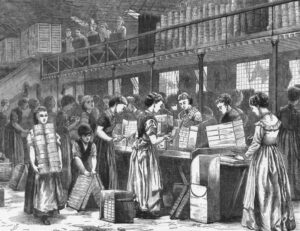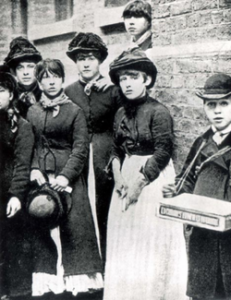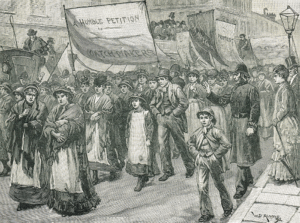 In 1887, Annie Besant and William Stead founded a newspaper that they called The Link. This halfpenny weekly featured on its front page a quote from Victor Hugo: “I will speak for the dumb. I will speak of the small to the great and the feeble to the strong… I will speak for all the despairing silent ones.” The newspaper campaigned against “sweated labour, extortionate landlords, unhealthy workshops, child labour and prostitution.” I’m sure these things made the owners hated among the labor bosses.
In 1887, Annie Besant and William Stead founded a newspaper that they called The Link. This halfpenny weekly featured on its front page a quote from Victor Hugo: “I will speak for the dumb. I will speak of the small to the great and the feeble to the strong… I will speak for all the despairing silent ones.” The newspaper campaigned against “sweated labour, extortionate landlords, unhealthy workshops, child labour and prostitution.” I’m sure these things made the owners hated among the labor bosses.
In June 1888, Clementina Black delivered a speech on Female Labour at a Fabian Society meeting in London. Annie Besant, who was in the audience, was appalled to learn about the wages and working conditions of the women at the Bryant and May match factory. Taking immediate action, Besant interviewed several employees of Bryant and May the very next day. She found out that the women labored for fourteen hours daily, earning less than five shillings per week. Their full wages were often reduced due to a fine system, which ranged from three pence to one shilling, enforced by the Bryant and May management for infractions such as talking, dropping matches, or using the restroom without permission. The workday started at 6:30am in summer (8:00am in winter) and ended at 6:00pm. Workers arriving late were penalized with a deduction of half a day’s wages.
Annie Besant found that the women’s health was drastically impacted by the phosphorus in the match-making process. It led to skin yellowing, hair loss, and “phossy jaw,” which is a type of bone cancer. The disease would turn one side of the face green, then black, emitting a foul odor before resulting in death. Despite phosphorus being outlawed in Sweden and the USA, the British government declined to enact a similar ban, citing free trade restrictions, and the health of the workers “be hanged.”
On June 23, 1888, Annie Besant published an article in her newspaper, The Link, titled “White Slavery in London,” which criticized the treatment of women at Bryant and May. The company responded by trying to coerce their workers into signing a declaration of satisfaction with their working conditions. When a group of  women refused to sign, the group’s organizers were dismissed. The reaction to the dismissals was swift…1,400 women at Bryant and May went on strike.
women refused to sign, the group’s organizers were dismissed. The reaction to the dismissals was swift…1,400 women at Bryant and May went on strike.
William Stead of the Pall Mall Gazette, Henry Hyde Champion from the Labour Elector, and Catharine Booth of the Salvation Army supported Besant’s campaign for improved factory working conditions. Hubert Llewellyn Smith, Sydney Oliver, Stewart Headlam, Hubert Bland, Graham Wallas, and George Bernard Shaw also joined the cause. Conversely, newspapers like The Times criticized Besant and other socialist leaders for the dispute, lamenting that “the matchgirls have been deprived of acting on their own but have been incited to strike by irresponsible advisors. No effort has been spared by these nuisances of the modern industrial world to escalate this conflict.”
Besant, Stead, and Champion leveraged their newspapers to advocate for a boycott of Bryant and May’s matches. Emmeline Pankhurst was among those who joined the strike. In her autobiography, she reflected, “I embraced this strike with zeal, collaborating with the girls and several distinguished women, including the renowned Mrs Annie Besant… It was a period marked by significant turmoil, labour disputes, strikes, and lockouts. It was also a time when an incredibly obtuse reactionary sentiment appeared to dominate the Government and the authorities.”
The women at the company decided to establish a Matchgirls’ Union, and Besant consented to lead it. Three weeks later, the company declared its willingness to rehire the dismissed women and abolish the fines system. The women agreed to these terms and returned triumphantly. The Bryant and May dispute became the first strike by unorganized workers to actually receive national attention and it successfully inspired the creation of unions nationwide.
Several years later, trade union leader Henry Snell reflected, “These brave girls, lacking funds, organization, or leaders, turned to Mrs Besant for guidance and leadership. It was an astute and superb inspiration. Although the number impacted was relatively small, the matchgirls’ strike profoundly influenced the workers’ mindset, earning it a place as one of the pivotal events in the annals of labor organization worldwide.”
Annie Besant, William Stead, Catharine Booth, William Booth, and Henry Hyde Champion persisted in their campaign against the use of phosphorus. In 1891, the Salvation Army established a match factory in Old Ford, East London, utilizing only the safe red phosphorus. The factory’s workers quickly ramped up production to six  million boxes annually. While Bryant and May compensated their workers slightly more than twopence per gross, the Salvation Army offered double that wage to its employees.
million boxes annually. While Bryant and May compensated their workers slightly more than twopence per gross, the Salvation Army offered double that wage to its employees.
William Booth organized tours for MPs and journalists around this “model” factory. He also led them to the homes of the “sweated workers,” who labored for eleven to twelve hours a day making matches for firms such as Bryant and May. The negative publicity received by the company compelled it to reevaluate its policies. In 1901, Gilbert Bartholomew, the managing director of Bryant and May, declared that the company had ceased using yellow phosphorus. It was a major victory for the matchgirls.


Leave a Reply